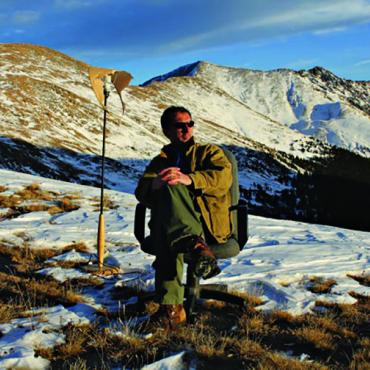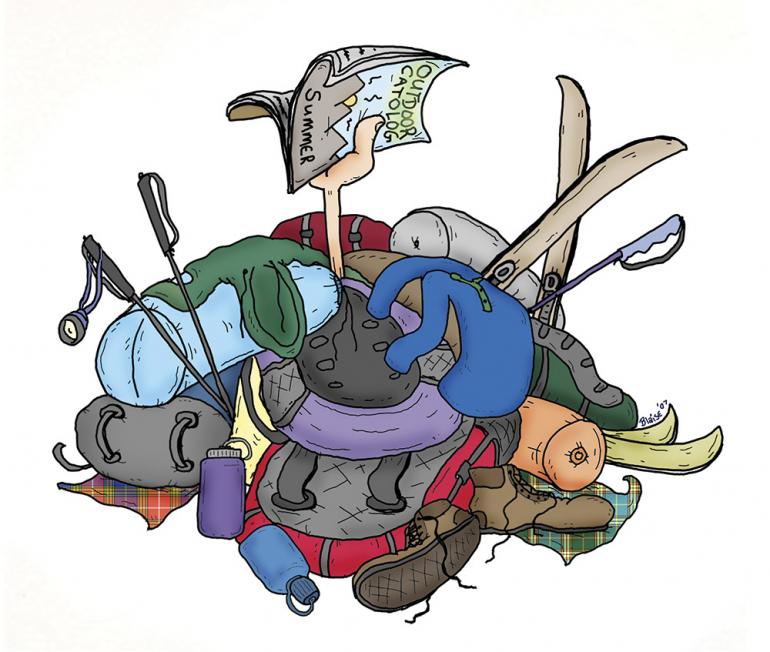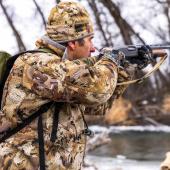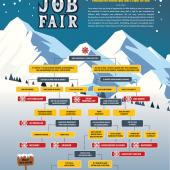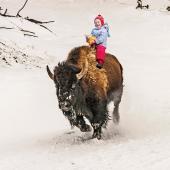The Root of My Addiction
Pondering the influence of outdoor catalogs.
I’m currently sitting at my kitchen table on a damp Tuesday afternoon attempting to confront my addiction to outdoor gear and clothing.
This admission spawned from a recent inventory that revealed I own three backpacks, four tents, seven fleece jackets, three rain parkas, two shells, three headlamps, four pairs of trekking poles, five daypacks, three sets of downhill skis, two pairs of hiking boots, six water bottles, and enough bandanas to outfit the entire bakery department staff at Safeway.
My love for shopping is not the cause. If given the choice, I would rather stand appendix-scar deep in an Arkansas swamp populated with hissing water moccasins while flipping through a swimsuit calendar featuring Alan Greenspan and Gale Norton than visit a store. The blame falls on outdoor catalogs.
I’m hopelessly vulnerable to their silent pitches that clandestinely express, “We sincerely hope that these pages of inordinately happy people adorned in inordinately bright-colored outdoor clothing will nosedive you into a wretched state of gloomy discontent that can only be rectified by dialing our 800 number and putting your American Express card to work.” It’s an amazingly effective soft-sell tactic that makes me ponder whether the R1 Flash Pullover that I mail-ordered from Patagonia last month is actually clothing or wearable Prozac.
Despite cognizance of the motives behind outdoor catalogs I’m defenseless to their sorcery. Especially at 1am with a magnum of wine in my head and a bag of tacos at my side. Most people’s hangovers involve cottonmouth and headaches. Mine involve dialing customer service and asking, “Is it too late to cancel last night’s order?
I once heeded the advice of a ski-bum friend, Batty Matty, and donned yellow-tinted glasses while paging through a catalog under the sophomoric promise it would dissuade me by making everything “look funky.” He was right. It made all the models appear as if they were suffering from low blood-sugar counts, but it also altered my color wheel. Six days later I was on the phone with Cloudevil grumbling that the orange Switchback jacket I had ordered was red.
The words outdoor catalogs use to name or describe products will sometimes sell me. I once ordered a spork. Not because I was in want of mutated cutlery but because I thought it would be funny to own a piece of trail equipment whose name looked like one of those Batman TV-show sound effects that were superimposed across the screen after a punch: Biff! Clunk! Spork!
But more so than anything else it’s the accompanying outdoor action photos that convince me that the word “catalog” is actually an acronym for Constantly Admonished To Accrue Lots Of Gear. The pictures not only sell a product but a lifestyle, heightening consumer expectations that all that’s missing from enjoying a life of endless adventure on mountains favored by an inordinate number of Viking-blond women who are always perfectly attired for the current weather conditions is a pair of quick-drying cargo shorts in this season’s hottest color, Arctic Streetlamp Green.
They say in Hollywood that the key to a good movie is whether viewers can relate to it. The same applies with catalog photos. And based on this criterion, I’m shocked at my susceptibility.
In scrutinizing the photos from the three catalogs I’ve ordered from in the last two months—REI, Patagonia, L.L. Bean—I share varying degrees of commonality with their subjects. However, when I ask, “Would I want to camp with these people?” the appeal factor of every photo plummets.
Most of REI’s shots feature dramatic backcountry settings busy with people hiking, backpacking, tending camp stoves, and running trails. Yet all are strangely impervious to sweat, dirt, and gear imperfection. I hike but 30 feet on a trail and my ankles are splayed with mud, my socks are clumped with burrs, and one of my trekking poles is already two feet shorter than the other. Their models are also immune to emotional swings. Everyone, regardless of the activity, is smiling. I guess I’d smile too if I never had to worry about sweat and dirt. Could I camp with them? Only if I didn’t have to share a tent. No one in REI’s pictures ever zips shut their tent flaps.
The people in L.L. Bean’s photos resemble the types who prefer Leno over Letterman. They have at least one shelf at home decorated with seashells and sand dollars. They listen to NPR even during fundraising drives. They don’t get wet while washing their cars, and they harbor an odd fascination with pumpkins, Labrador retrievers, and chatting on wood-planked porches while holding tote bags. Could I camp with them? Probably not. Roughing it to these people is eating lobster without a bib. Plus, they don’t zip their tents either.
Patagonia is my Achilles heel of mail ordering. I identify with the dirtbag authenticity of their photos. But 75 percent of their pictures feature people with their backs turned to the camera, which conjures sour memories of arguing with my girlfriend on the trail and then having to face the same back-look for the next six hours. Could I camp with them? Yes and no. Everyone zips their tents. But some subjects look too diehard, reminding me of last year’s backpacking experience with a guide who took “leave no trace” to the infinite-extreme. Instead of backpacking I felt as if we were fleeing the law.
It was while pondering all of this that the doorbell buzzed, making me suddenly realize that the catalogs are not to blame for my gear addiction. It’s the UPS lady who keeps delivering the stuff.


